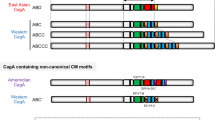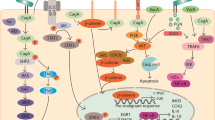Abstract
Infection with Helicobacter pylori (H. pylori) is a risk factor for the development of gastric cancer. Here we show that infection of gastric epithelial cells with 'cag' pathogenicity island (cagPAI)-positive H. pylori induced aberrant expression of activation-induced cytidine deaminase (AID), a member of the cytidine-deaminase family that acts as a DNA- and RNA-editing enzyme, via the IκB kinase–dependent nuclear factor-κB activation pathway. H. pylori–mediated upregulation of AID resulted in the accumulation of nucleotide alterations in the TP53 tumor suppressor gene in gastric cells in vitro. Our findings provide evidence that aberrant AID expression caused by H. pylori infection might be a mechanism of mutation accumulation in the gastric mucosa during H. pylori–associated gastric carcinogenesis.
This is a preview of subscription content, access via your institution
Access options
Subscribe to this journal
Receive 12 print issues and online access
$209.00 per year
only $17.42 per issue
Buy this article
- Purchase on Springer Link
- Instant access to full article PDF
Prices may be subject to local taxes which are calculated during checkout




Similar content being viewed by others
References
Schistosomes, liver flukes and Helicobacter pylori. IARC Working Group on the Evaluation of Carcinogenic Risks to Humans. Lyon, 7–14 June 1994 IARC Monogr. Eval. Carcinog. Risks Hum. 61, 1–241 (1994).
Tomb, J.F. et al. The complete genome sequence of the gastric pathogen Helicobacter pylori. Nature 388, 539–547 (1997).
Blaser, M.J. Helicobacter pylori and gastric diseases. Br. Med. J. 316, 1507–1510 (1998).
Peek, R.M., Jr et al. Heightened inflammatory response and cytokine expression in vivo to cagA+ Helicobacter pylori strains. Lab. Invest. 73, 760–770 (1995).
Crabtree, J.E. et al. Systemic and mucosal humoral responses to Helicobacter pylori in gastric cancer. Gut 34, 1339–1343 (1993).
Blaser, M.J. et al. Infection with Helicobacter pylori strains possessing cagA is associated with an increased risk of developing adenocarcinoma of the stomach. Cancer Res. 55, 2111–2115 (1995).
Parsonnet, J., Friedman, G.D., Orentreich, N. & Vogelman, H. Risk for gastric cancer in people with CagA positive or CagA negative Helicobacter pylori infection. Gut 40, 297–301 (1997).
Zhang, H. et al. The cytidine deaminase CEM15 induces hypermutation in newly synthesized HIV-1 DNA. Nature 424, 94–98 (2003).
Honjo, T., Kinoshita, K. & Muramatsu, M. Molecular mechanism of class switch recombination: linkage with somatic hypermutation. Annu. Rev. Immunol. 20, 165–196 (2002).
Wedekind, J.E., Dance, G.S., Sowden, M.P. & Smith, H.C. Messenger RNA editing in mammals: new members of the APOBEC family seeking roles in the family business. Trends Genet. 19, 207–216 (2003).
Cascalho, M. Advantages and disadvantages of cytidine deamination. J. Immunol. 172, 6513–6518 (2004).
Kinoshita, K. & Nonaka, T. The dark side of activation-induced cytidine deaminase: relationship with leukemia and beyond. Int. J. Hematol. 83, 201–207 (2006).
Okazaki, I.M. et al. Constitutive expression of AID leads to tumorigenesis. J. Exp. Med. 197, 1173–1181 (2003).
Kou, T. et al. Expression of activation-induced cytidine deaminase in human hepatocytes during hepatocarcinogenesis. Int. J. Cancer 120, 469–476 (2007).
Greeve, J. et al. Expression of activation-induced cytidine deaminase in human B-cell non-Hodgkin lymphomas. Blood 101, 3574–3580 (2003).
Albesiano, E. et al. Activation-induced cytidine deaminase in chronic lymphocytic leukemia B cells: expression as multiple forms in a dynamic, variably sized fraction of the clone. Blood 102, 3333–3339 (2003).
Pasqualucci, L. et al. Expression of the AID protein in normal and neoplastic B cells. Blood 104, 3318–3325 (2004).
Lossos, I.S., Levy, R. & Alizadeh, A.A. AID is expressed in germinal center B-cell-like and activated B-cell-like diffuse large-cell lymphomas and is not correlated with intraclonal heterogeneity. Leukemia 18, 1775–1779 (2004).
Hollstein, M., Sidransky, D., Vogelstein, B. & Harris, C.C. p53 mutations in human cancers. Science 253, 49–53 (1991).
Segal, E.D., Falkow, S. & Tompkins, L.S. Helicobacter pylori attachment to gastric cells induces cytoskeletal rearrangements and tyrosine phosphorylation of host cell proteins. Proc. Natl. Acad. Sci. USA 93, 1259–1264 (1996).
Faili, A. et al. AID-dependent somatic hypermutation occurs as a DNA single-strand event in the BL2 cell line. Nat. Immunol. 3, 815–821 (2002).
Babbage, G., Ottensmeier, C.H., Blaydes, J., Stevenson, F.K. & Sahota, S.S. Immunoglobulin heavy chain locus events and expression of activation-induced cytidine deaminase in epithelial breast cancer cell lines. Cancer Res. 66, 3996–4000 (2006).
Peek, R.M., Jr. IV. Helicobacter pylori strain-specific activation of signal transduction cascades related to gastric inflammation. Am. J. Physiol. Gastrointest. Liver Physiol. 280, G525–G530 (2001).
Keates, S., Hitti, Y.S., Upton, M. & Kelly, C.P. Helicobacter pylori infection activates NF-κB in gastric epithelial cells. Gastroenterology 113, 1099–1109 (1997).
Doi, T., Kinoshita, K., Ikegawa, M., Muramatsu, M. & Honjo, T. De novo protein synthesis is required for the activation-induced cytidine deaminase function in class-switch recombination. Proc. Natl. Acad. Sci. USA 100, 2634–2638 (2003).
Stock, M. & Otto, F. Gene deregulation in gastric cancer. Gene 360, 1–19 (2005).
Ramiro, A.R., Stavropoulos, P., Jankovic, M. & Nussenzweig, M.C. Transcription enhances AID-mediated cytidine deamination by exposing single-stranded DNA on the nontemplate strand. Nat. Immunol. 4, 452–456 (2003).
Chaudhuri, J. et al. Transcription-targeted DNA deamination by the AID antibody diversification enzyme. Nature 422, 726–730 (2003).
Peek, R.M., Jr. & Blaser, M.J. Helicobacter pylori and gastrointestinal tract adenocarcinomas. Nat. Rev. Cancer 2, 28–37 (2002).
Morgan, C. et al. Detection of p53 mutations in precancerous gastric tissue. Br. J. Cancer 89, 1314–1319 (2003).
Yoshikawa, K. et al. AID enzyme-induced hypermutation in an actively transcribed gene in fibroblasts. Science 296, 2033–2036 (2002).
Fenoglio-Preiser, C.M., Wang, J., Stemmermann, G.N. & Noffsinger, A. TP53 and gastric carcinoma: a review. Hum. Mutat. 21, 258–270 (2003).
Karin, M. Nuclear factor-κB in cancer development and progression. Nature 441, 431–436 (2006).
Muramatsu, M. et al. Specific expression of activation-induced cytidine deaminase (AID), a novel member of the RNA-editing deaminase family in germinal center B cells. J. Biol. Chem. 274, 18470–18476 (1999).
Dedeoglu, F., Horwitz, B., Chaudhuri, J., Alt, F.W. & Geha, R.S. Induction of activation-induced cytidine deaminase gene expression by IL-4 and CD40 ligation is dependent on STAT6 and NF-κB. Int. Immunol. 16, 395–404 (2004).
Viala, J. et al. Nod1 responds to peptidoglycan delivered by the Helicobacter pylori cag pathogenicity island. Nat. Immunol. 5, 1166–1174 (2004).
Chiba, T., Seno, H., Marusawa, H., Wakatsuki, Y. & Okazaki, K. Host factors are important in determining clinical outcomes of Helicobacter pylori infection. J. Gastroenterol. 41, 1–9 (2006).
Glickman, J.N. & Antonioli, D.A. Gastritis. Gastrointest. Endosc. Clin. N. Am. 11, 717–740 (2001).
Uchida, K. et al. Analysis of cytokines in the early development of gastric secondary lymphoid follicles in Helicobacter pylori-infected BALB/c mice with neonatal thymectomy. Infect. Immun. 69, 6749–6754 (2001).
Matsumoto, Y. et al. Eradication of Helicobacter pylori and resolution of gastritis in the gastric mucosa of IL-10-deficient mice. Helicobacter 10, 407–415 (2005).
Marusawa, H., Hijikata, M., Watashi, K., Chiba, T. & Shimotohno, K. Regulation of Fas-mediated apoptosis by NF-κB activity in human hepatocyte derived cell lines. Microbiol. Immunol. 45, 483–489 (2001).
Ta, V.T. et al. AID mutant analyses indicate requirement for class-switch-specific cofactors. Nat. Immunol. 4, 843–848 (2003).
Iwai, A. et al. Role of a novel oncogenic protein, gankyrin, in hepatocyte proliferation. J. Gastroenterol. 38, 751–758 (2003).
Toda, Y. et al. Application of tyramide signal amplification system to immunohistochemistry: a potent method to localize antigens that are not detectable by ordinary method. Pathol. Int. 49, 479–483 (1999).
Kanda, N. et al. Involvement of cyclooxygenase-2 in gastric mucosal hypertrophy in gastrin transgenic mice. Am. J. Physiol. Gastrointest. Liver Physiol. 290, G519–G527 (2006).
Acknowledgements
We thank J.C. Weill (Faculte de Medecine Necker-Enfants Malades) for AID-deficient BL2 cells; A. Nomura, S. Sato and Y. Sakai (Kyoto University) for gastric tissue specimens; and H. Haga (Kyoto University) for assistance in the staining of H. pylori. This study was supported by a grant-in-aid for Scientific Research from the Japan Society for the Promotion of Science (15209024, 16790378 and 17002015).
Author information
Authors and Affiliations
Contributions
Y.M. conducted all the experiments except the analyses of Ig gene, and contributed to manuscript preparations. H.M. designed the study, supervised the project and contributed to manuscript preparations. K.K. performed the analyses of Ig gene, supervised the project and contributed to manuscript preparations. Y.E. worked on in vitro analyses related to NF-κB signaling. T.K. collected human samples and conducted analyses on them. T.M. analysed the transgenic mice. T.A. generated the isogenic cagE-knockout mutant of H. pylori. I.-M.O. generated and analysed the transgenic mice. T.H. and T.C. supervised the project and contributed to manuscript preparations.
Corresponding author
Ethics declarations
Competing interests
The authors declare no competing financial interests.
Supplementary information
Supplementary Fig. 1
CagPAI-positive H. pylori infection induces morphologic changes in AGS gastric epithelial cells. (PDF 546 kb)
Supplementary Fig. 2
Detection of variable (V)-region gene rearrangement of the Ig gene. (PDF 255 kb)
Supplementary Fig. 3
Treatment with NF-κB signaling regulators did not affect the expression levels of transcripts encoding the cell cycle regulators cyclin D and E in gastric epithelial cells. (PDF 160 kb)
Supplementary Fig. 4
AID-induced mutagenesis in cancer-related genes in association with H. pylori infection. (PDF 155 kb)
Supplementary Fig. 5
AID induction and Trp53 mutation frequencies in wild type mice after H. pylori infection. (PDF 350 kb)
Supplementary Fig. 6
Immunohistochemical analysis of AID expression in H. pylori-positive human gastric mucosa. (PDF 1104 kb)
Supplementary Table 1
TP53 mutation frequencies in human gastric cancers, gastritis and normal mucosa in association with AICDA expression levels. (PDF 93 kb)
Supplementary Table 2
The oligonucleotide primers used in this study. (PDF 73 kb)
Rights and permissions
About this article
Cite this article
Matsumoto, Y., Marusawa, H., Kinoshita, K. et al. Helicobacter pylori infection triggers aberrant expression of activation-induced cytidine deaminase in gastric epithelium. Nat Med 13, 470–476 (2007). https://doi.org/10.1038/nm1566
Received:
Accepted:
Published:
Issue Date:
DOI: https://doi.org/10.1038/nm1566
This article is cited by
-
The clinical significance of some serum tumor markers among chronic patients with Helicobacter pylori infections in Ibb Governorate, Yemen
Infectious Agents and Cancer (2023)
-
Role of the gut microbiota in anticancer therapy: from molecular mechanisms to clinical applications
Signal Transduction and Targeted Therapy (2023)
-
Mutational signatures reveal mutual exclusivity of homologous recombination and mismatch repair deficiencies in colorectal and stomach tumors
Scientific Data (2023)
-
Mutational spectrum of TP53 gene correlates with nivolumab treatment efficacy in advanced gastric cancer (TP53MUT study)
British Journal of Cancer (2023)
-
Molecular mechanisms underlying the action of carcinogens in gastric cancer with a glimpse into targeted therapy
Cellular Oncology (2022)



